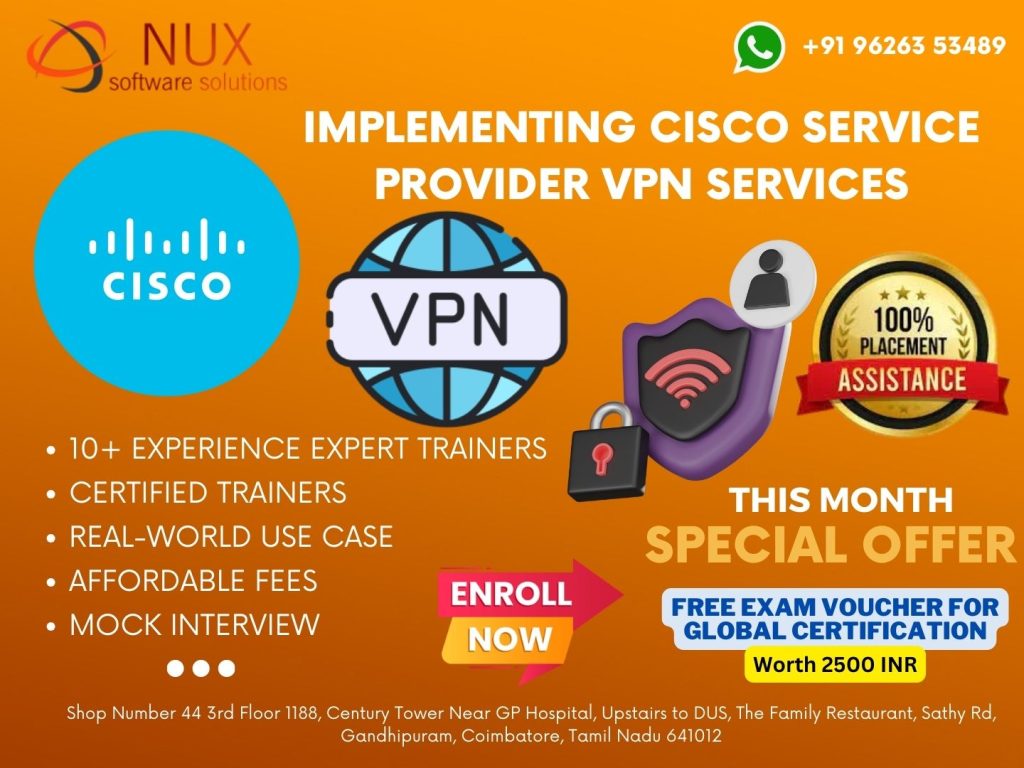Cisco Service Provider Advanced Routing Solutions (SPRI) 300-510

Cisco SPRI 300-510 Training in Coimbatore
(Service Provider Advanced Routing Solutions Certification)
Course Overview
The Cisco Service Provider Advanced Routing Solutions (SPRI 300-510) course is a concentration exam within the CCNP Service Provider certification path, designed for engineers who want to master advanced routing techniques in a service provider environment. This course focuses on complex routing technologies such as MPLS, segment routing, routing policy language (RPL), and multicast, giving learners the deep expertise required to build and maintain highly available, scalable provider networks.
At Linux Training Center in Coimbatore, the SPRI training is delivered with a hands-on approach, combining theoretical depth with real-world labs. This course ensures that you gain the practical skills needed to solve core routing challenges in service provider environments.
Why Choose SPRI 300-510?
Service providers operate some of the most demanding networks, where efficiency, redundancy, and scalability are critical. The SPRI certification builds on foundational routing knowledge and advances into multi-protocol label switching (MPLS), segment routing, and traffic engineering — enabling engineers to design and operate robust backbones and edge networks.
This course is highly recommended for professionals responsible for BGP routing, MPLS Layer 3 VPNs, and advanced path optimization techniques, as well as those pursuing the CCNP or CCIE Service Provider certifications.
Who Should Enroll?
This course is ideal for:
-
Core Network and ISP Engineers
-
Senior Routing and Network Architects
-
Professionals managing large-scale BGP/MPLS service provider infrastructures
-
Network consultants and engineers working with routing protocols like OSPF, IS-IS, and BGP
-
Candidates preparing for SPRI 300-510 exam as part of their CCNP Service Provider certification
Prior experience with service provider routing or completion of SPCOR 350-501 is recommended.
What You Will Learn
-
Implementing advanced routing protocols: IS-IS, OSPF, and BGP
-
Configuring MPLS Layer 3 VPNs and VPNv4/v6 route distribution
-
Implementing Segment Routing with SR-MPLS and SRv6
-
BGP route reflectors, confederations, and BGP policy controls
-
MPLS Traffic Engineering (TE) for optimized path selection
-
Route Policy Language (RPL) configuration and route manipulation
-
Understanding multicast routing protocols such as PIM and IGMP
-
Troubleshooting complex routing issues in provider environments
This course includes deep-dive labs to give you practical hands-on experience with Cisco IOS XR, XE, and NX-OS.
Course Highlights
-
Cisco-certified expert instructors with real-world SP background
-
Fully lab-based curriculum with hands-on implementation
-
Real-case use of BGP and MPLS in SP topologies
-
Online and classroom learning options
-
Aligned with the latest Cisco exam blueprint
-
Prepares you for success in SPRI 300-510 certification exam
Career Opportunities
Professionals who complete this course are prepared for senior roles such as IP/MPLS Network Engineer, Core Routing Specialist, Network Architect – Service Provider, and BGP/MPLS Consultant. SPRI certification also brings you one step closer to achieving CCNP or CCIE Service Provider status, a benchmark for advanced SP careers.
Why Linux Training Center, Coimbatore?
At Linux Training Center, we focus on delivering career-centric Cisco training that combines in-depth knowledge, practical skills, and mentorship. Our Cisco SPRI course empowers you to design, implement, and troubleshoot complex service provider networks with confidence.
Cisco Service Provider Advanced Routing Solutions (SPRI) 300-510 Syllabus
Unicast Routing – 35%
– Compare OSPF and IS-IS routing protocols
– Troubleshoot OSPF multiarea operations (IPv4 and IPv6)
Route advertisement
Summarization
– Troubleshoot IS-IS multilevel operations (IPv4 and IPv6)
Route advertisement
Summarization
– Describe the BGP scalability and performance
BGP confederations
Route reflectors
– Troubleshoot BGP
Route advertisement
Route reflectors
Confederations
Multihoming
TTL security and inter-domain security
Maximum prefix
Route dampening
Dynamic neighbors
Communities
– Describe IPv6 tunneling mechanisms
Static IPv6-in-IPv4 tunnels
Dynamic 6to4 tunnels
IPv6 provider edge (6PE)
– Implement fast convergence
Bidirectional forwarding detection
Nonstop Forwarding
NSR
Timers
BGP pic (edge and core)
LFA
BGP additional and backup path
Multicast Routing – 15%
– Compare multicast concepts
- Multicast domains, distribution trees, and IGMP operations,
Any-Source Multicast (ASM) versus Source Specific Multicast (SSM),
Intra-domain versus inter-domain multicast routing
– Describe multicast concepts
- Mapping of multicast IP addresses to MAC addresses,
Multiprotocol BGP for IPv4 and IPv6,
Principles and operations of PIM-SM,
Multicast Source Discovery Protocol (MSDP) operations,
MLDP/P2MP
– Implement PIM-SM operations
- Auto-RP, PIMv2 BSR, anycast RP,
BIDIR-PIM operations,
SSM operations,
MSDP operations
– Troubleshoot multicast routing
- Single domain,
Multidomain
Routing Policy and Manipulation – 25%
– Compare routing policy language and route maps
– Describe conditional matching
-
Operations,
Semantics of policy applications and statements,
Regular expressions,
Policy sets,
Tags,
ACLs,
Prefix lists and prefix sets,
Route types,
BGP attributes and communities,
Hierarchical and parameterized structures
– Troubleshoot route manipulation for IGPs
- IS-IS,
OSPF
– Troubleshoot route manipulation for BGP
- Route filtering,
Traffic steering
MPLS and Segment Routing – 25%
– Troubleshoot MPLS
- LDP,
LSP,
Unified BGP,
BGP free core,
RSVP TE tunnels
– Implement segment routing
-
Routing protocol extensions (OSPF, IS-IS, BGP),
SRGB and SRLB,
Topology-Independent Loop-Free Alternate (TI-LFA),
Migration procedures (SR prefer and mapping server)
– Describe segment routing traffic engineering
- Automated steering and coloring,
Policies (constraints, metrics, and attributes),
PCE-based path calculation
– Describe segment routing v6 (SRv6)
-
Control plane operations,
Data plane operations
Security – 15%
1. Apply network security
-
⦁ AAA and RBAC
⦁ ACI contracts and microsegmentation
⦁ First-hop security features
⦁ Keychain authentication
2. Apply compute security
- AAA and RBAC
3. Apply storage security
⦁ AAA and RBAC
⦁ Port security
⦁ Fabric binding



